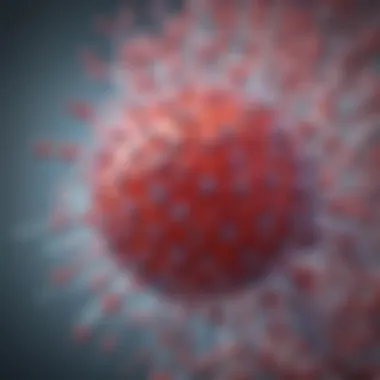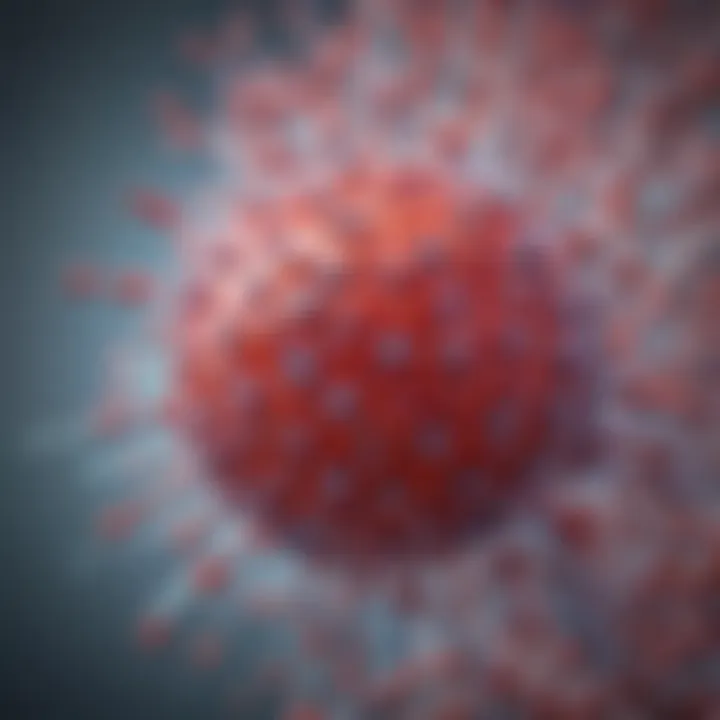Mechanisms of HIV Entry into Host Cells Explained


Intro
The Human Immunodeficiency Virus (HIV) remains a significant global health concern, primarily due to its capability to infiltrate host cells and subsequently disrupt the immune system. Understanding how HIV enters host cells is crucial for developing therapeutic strategies aimed at preventing infection and treating the disease. This article delves deep into the mechanistic aspects of HIV's entry, offering insights into the molecular architecture of the virus, its interactions with host cell receptors, and the implications these interactions have for therapeutic interventions.
Article Overview
Purpose of the Article
Relevance to Multiple Disciplines
The study of HIV entry mechanisms intersects various fields, including virology, immunology, and molecular biology. Researchers and professionals in these disciplines will find value in the article as it compiles current knowledge, bridging gaps between basic science and clinical applications. Furthermore, the insights can inform future studies aimed at vaccine development and innovative antiviral strategies.
Research Background
Historical Context
The paradigms of HIV research have evolved significantly since the virus was first identified in the early 1980s. Initial studies focused on the epidemiology and pathology of the virus. As molecular techniques advanced, researchers began to unravel how HIV interacts with the immune cells, particularly CD4 T-lymphocytes. Understanding HIV's entry mechanisms has since been recognized as vital for developing effective treatments and prevention strategies.
Key Concepts and Definitions
To fully grasp the mechanisms of HIV entry, it is essential to define some key concepts:
- Viral Envelope: The outer layer of HIV composed of lipids and proteins, crucial for fusion with host cells.
- Receptors: Molecules on the surface of host cells that HIV binds to for entry; primarily includes CD4 and co-receptors like CCR5 and CXCR4.
- Fusion Process: The actual merging of the viral envelope with the host cell membrane, enabling the release of viral genetic material into the host cell.
Understanding these components provides a framework for comprehending the intricacies of HIV infection, setting the stage for the detailed exploration that follows.
Prelims to HIV and its Significance
Understanding the mechanisms through which the Human Immunodeficiency Virus (HIV) enters host cells is vital in the fields of virology and medicine. A comprehensive grasp of this topic helps us to develop targeted therapies and interventions. There are several layers to this discussion.
First, HIV remains a significant global health issue. Despite advancements in treatment and prevention, new infections continue to occur, necessitating a thorough understanding of its mode of action. Insights into viral entry mechanisms can inform the development of vaccines and antiviral therapies.
Second, knowledge of how HIV binds and enters cells allows researchers to identify potential points for intervention. This can help in designing strategies to block the virus before it can replicate inside the host. The significance of understanding these mechanisms is not merely academic — it has real-world implications that can save lives.
Overview of HIV
HIV is a retrovirus that primarily targets the immune system, particularly CD4+ T cells. It causes a progressive decline in immune function, leading to Acquired Immunodeficiency Syndrome (AIDS), which makes individuals susceptible to opportunistic infections and various cancers. The virus is composed of a core containing its RNA and proteins, surrounded by a lipid envelope.
Epidemiology and Impact
HIV/AIDS is a critical public health concern worldwide. According to the World Health Organization, approximately 38 million people are living with HIV globally. The epidemic's varied impact across different regions is evident, with higher prevalence in sub-Saharan Africa.
The societal impact of HIV is profound. It affects not only individuals but entire communities. The stigma associated with HIV/AIDS often hinders testing and treatment, exacerbating the issue. Continued education and awareness are necessary to mitigate these effects and improve access to care.
Understanding the Structure of HIV
Understanding the structure of the Human Immunodeficiency Virus (HIV) is essential for comprehending how the virus interacts with host cells. This section highlights specific elements that are crucial in the entry mechanisms and offers insights into the benefits and considerations associated with the viral structure. A detailed grasp of HIV’s architecture provides invaluable context for researchers and health practitioners who aim to develop effective interventions against the virus.


Viral Components
HIV comprises several key components that work together to facilitate infection. The virus is primarily made up of the following elements:
- Envelope: The outer layer is made up of lipids derived from the host cell. This envelope contains crucial proteins vital for infection.
- Nucleocapsid: This area houses the viral RNA and proteins necessary for replicating the virus once it enters the host cell.
- Proteins: HIV has several proteins such as Gag, Pol, and Env. Each of these plays a distinct role during the lifecycle of the virus.
Understanding these components allows for the recognition of how HIV adapts to its environment and evades the immune system. Specific viral proteins are involved directly in facilitating the entry into host cells by engaging with host receptors.
Surface Proteins and Their Roles
The interaction of HIV with host cells heavily relies on its surface proteins, which serve as mediators of attachment and entry. The Envelope Glycoprotein (Env) is the most significant among them. Env consists of two main subunits: gp120 and gp41.
- gp120 is responsible for initial binding to the CD4 receptor on host T cells. This step is critical as it triggers subsequent events necessary for entry.
- gp41 facilitates the fusion of the viral and host cell membranes. It ensures that the viral content is delivered into the cell's interior.
The role of surface proteins is not just structural; they are also targets for immune responses and therapeutic strategies.
The role of surface proteins is not just structural; they are also targets for immune responses and therapeutic strategies.
The manipulation of these proteins is vital in designing antiretroviral therapies. By understanding how these proteins function, scientists can design inhibitors that effectively block viral entry and prevent infection.
This knowledge forms the bedrock of therapeutic implications, making the understanding of HIV's structure crucial for advancing treatment and prevention strategies.
Mechanisms of HIV Entry
Initial Attachment
The initial attachment of HIV to host cells is a decisive step in the infection process. This occurs predominantly through the viral envelope protein gp120, which binds to the CD4 receptor on the surface of immunological cells. This interaction is specific and highly efficient, demonstrating how viruses have evolved mechanisms to recognize and exploit host cell receptors. After the gp120 protein attaches to CD4, a conformational change occurs that is necessary for the next steps in the entry process. Without this initial binding, HIV cannot effectively penetrate the host cell, highlighting its significance in the infection cycle.
Role of CD4 Receptors
CD4 receptors have a pivotal role in HIV entry. These receptors are primarily found on the surface of T-helper cells, but they are also present in other immune cells. The interaction between CD4 and gp120 does more than just facilitate attachment; it also triggers a cascade of molecular events that prepare the virus for subsequent entry into the cell. The binding of gp120 induces a shift in the viral structure, allowing it to engage additional receptors known as co-receptors. This initial interaction thus sets the stage for a more significant entry sequence, underscoring the central importance of CD4 in the infection mechanism.
Co-receptor Engagement
Once HIV binds to the CD4 receptor, the next critical phase involves the engagement of co-receptors. The most commonly utilized co-receptors are CCR5 and CXCR4. The choice of co-receptor significantly influences the tropism of the virus. HIV strains that utilize CCR5 are termed R5-tropic, while those using CXCR4 are X4-tropic. This distinction is vital for understanding different stages of disease progression and potential therapeutic targets. Activation of these co-receptors further stabilizes the virus-host cell interaction and facilitates the fusion process that is essential for HIV to deliver its genetic material into the host cell. Understanding this engagement process contributes to developing resistance strategies and improving treatment modalities.
The Fusion Process
The fusion process is a crucial mechanism by which the Human Immunodeficiency Virus (HIV) enters host cells. Understanding this process is essential not only for grasping the complexities of HIV infection but also for informing therapeutic strategies. The fusion process enables the virus to seamlessly integrate its genetic material into the host cell, initiating the trajectory toward viral replication. A comprehensive analysis of this process reveals specific elements, benefits, and critical considerations relevant to HIV biology and treatment.
Mechanics of Membrane Fusion
Membrane fusion is the pivotal step that allows HIV to merge with the host cell membrane. This operation is facilitated by viral envelope proteins, mainly the glycoprotein 120 (gp120) and gp41. The sequence begins when gp120 binds to the CD4 receptor on the host cell surface. This engagement triggers conformational changes in the viral proteins, leading to the exposure of gp41.
At this point, gp41 facilitates the merger of the viral and cellular membranes. The mechanism involves a series of interactions that reduce energy barriers, allowing the membranes to intermingle. Key to this process is the creation of a fusion pore, a small opening that ultimately allows the viral content to pour into the cytoplasm of the host cell. This step is critical as it sets the stage for the subsequent entry of the viral components.
Entry of Viral RNA and Proteins
Once the fusion pore is formed, the transfer of viral RNA and proteins into the host cell follows. This step marks a significant transition from viral entry to the intracellular phase of infection. Viral RNA, along with essential proteins, including the reverse transcriptase enzyme, are released into the cytoplasm. The reverse transcriptase is crucial for converting viral RNA into DNA, an essential process for successful HIV replication.


The entry of these components influences the host cellular environment in several ways:
- It alters the cellular machinery to favor viral replication.
- It can trigger immune responses directed against the virus.
- It marks the beginning of the viral lifecycle within the host, leading to further viral proliferation.
Understanding the fusion process and its mechanics is pivotal in designing interventions that can block HIV entry, potentially halting the viral lifecycle before it begins.
Understanding the fusion process and its mechanics is pivotal in designing interventions that can block HIV entry, potentially halting the viral lifecycle before it begins.
In summary, the fusion process represents a sophisticated mechanism that underpins HIV's ability to infect host cells. By dissecting the mechanics of membrane fusion and the subsequent entry of viral components, researchers can develop targeted therapies to disrupt these processes and improve the outcomes for individuals living with HIV.
Cellular Environment: A Supportive Habitat
Understanding the cellular environment is crucial for comprehending how HIV effectively enters host cells. The cellular architecture and composition provide a selective yet accommodating space where viral interactions can take place. This habitat not only supports the entry of HIV but also influences subsequent steps in the viral lifecycle, shaping how the infection progresses.
The host cell environment comprises various structures and components that play pivotal roles in the HIV entry process. For instance, the presence of dietary lipids and cholesterol within the phospholipid bilayer of the cell membrane impacts the fluidity and overall dynamics of membrane fusion. Additionally, cytoskeletal elements facilitate viral transport and endocytosis, allowing HIV to navigate through the crowded intracellular landscape.
Moreover, the endoplasmic reticulum and Golgi apparatus are significant as they govern the post-entry processes. Once HIV gains entry, these organelles can affect the release of viral components into the cytoplasm, guiding the virus to achieve its replication phase.
"The supportive cellular environment for HIV highlights the co-evolution of the virus and host cells, where enhanced compatibility may lead to greater virulence."
"The supportive cellular environment for HIV highlights the co-evolution of the virus and host cells, where enhanced compatibility may lead to greater virulence."
Host Cellular Structures Involved
Several specific host cellular structures are integral to HIV entry. Key receptors at the surface, such as CD4 and co-receptors, enable the virus to bind and initiate fusion.
- Cell Membrane: Acts as the first line of interaction for HIV, featuring receptors that HIV latches onto.
- Endosomes: Following attachment, HIV may enter via endocytosis, allowing the virus to exploit these intracellular compartments for fusion.
- Cellular Microtubules: These structures assist in transporting the viral particles towards specific sites where fusion and subsequent replication may occur.
The interplay of these structures creates a conducive environment for HIV to penetrate the host cell.
Influence of Cellular Responses
The cellular responses to HIV entry significantly modulate the virus's fate after penetrating the host cell. Once inside, the host cell attempts to recognize and combat the viral intruder through various mechanisms.
- Immediate Immune Responses: Cells can produce interferons, triggering a cascade of responses aimed at limiting viral replication.
- Apoptosis: Some cells may undergo programmed cell death in response to HIV entry, which might be an attempt to eliminate the virus before it can replicate.
- Cytokine Production: The release of cytokines can enhance the immune response but may also facilitate HIV replication through chronic inflammation.
These cellular responses not only reflect the innate defense mechanisms but also show how HIV can adapt and persist in an environment initially hostile to its presence. Understanding these interactions is vital for advancing therapeutic strategies against HIV.
Consequences of HIV Entry
Understanding the consequences of HIV entry into host cells is crucial for unraveling the complexities of HIV infection and its subsequent pathogenesis. This knowledge holds significant implications for both clinical interventions and epidemiological studies, aiding in the design of effective therapies against HIV. When HIV successfully enters a host cell, it initiates a cascade of events leading to viral replication and persistence, ultimately resulting in immune system compromise. The consequences can be analyzed in two key areas: viral replication within host cells and the interaction between the virus and the immune system.
Viral Replication in Host Cells
Once inside the host cell, HIV undergoes reverse transcription, where its RNA genome is converted into DNA. This process is facilitated by the enzyme reverse transcriptase, a hallmark of retroviral biology. The newly formed viral DNA integrates into the host cell's genomic DNA using the integration enzyme integrase. This incorporation allows the virus to hijack the host's cellular machinery for its replication.
After integration, the host cell becomes a factory for producing new virions. The cellular transcription and translation mechanisms promote the expression of viral proteins, which assemble into new HIV particles. By exploiting the host cell's resources, HIV replicates itself, leading to an exponential increase in viral load. This relentless replication continues as long as the host cell remains viable, contributing to the chronic nature of HIV infections.
The process involves several stages:


- Reverse Transcription: RNA is converted to DNA.
- Integration: Viral DNA merges with host DNA.
- Transcription: The host mechanisms synthesize viral RNA and proteins.
- Assembly and Budding: New virions are assembled and released from the host cell.
The implications of this replication are profound, as it directly correlates with disease progression and the emergence of drug resistance, complicating treatment efforts.
Immune System Interaction
HIV's entry into host cells profoundly impacts the immune system. The virus specifically targets CD4+ T cells, which are pivotal in orchestrating the immune response. As HIV replicates within these cells, it results in their gradual depletion, leading to a state of immunosuppression. This diminished immune function heightens the vulnerability of the host to opportunistic infections and certain cancers, which are hallmark features of Acquired Immunodeficiency Syndrome (AIDS).
The interaction between HIV and the immune system can be further understood by considering the following factors:
- T Cell Activation: Initially, HIV entry can stimulate T cell activation, which paradoxically may enhance viral replication.
- Chronic Immune Activation: Persistent HIV infection keeps the immune system in a constant state of activation, depleting resources and leading to T cell exhaustion.
- Dysregulated Cytokine Responses: HIV alters the balance of cytokine production, key players in immune signaling, resulting in impaired immune responses.
In essence, the consequences of HIV entry extend beyond mere viral replication. They encapsulate a complex interplay between viral and host factors, underscoring the urgent need for targeted therapeutic strategies that can effectively disrupt this cycle of infection and immune evasion.
Therapeutic Implications
Understanding the mechanisms through which HIV enters host cells has significant therapeutic implications. It informs the development of treatments and preventive measures, enhancing our ability to combat this virus effectively. Recognizing these entry processes allows researchers to target specific interactions, which is essential for creating effective antiretroviral therapies and designing vaccines. Better comprehension also leads to improvements in existing therapies and opens new avenues for research.
Antiretroviral Therapies
Antiretroviral therapies (ART) are critical to managing HIV infection. These treatments aim to suppress the viral load and improve the immune function of patients. ART usually involves a combination of drugs that work at different stages of the HIV lifecycle.
- Inhibition of Entry: Certain drugs target the initial steps of HIV entry into host cells, disrupting the interaction between viral proteins and host receptors. Examples include Entry Inhibitors such as Maraviroc, which blocks the CCR5 co-receptor.
- Preventing Fusion: Fusion inhibitors, like Enfuvirtide, prevent the viral envelope from merging with the host cell membrane. This is crucial as it halts the virus from delivering its genetic material into the target cell.
- Reverse Transcriptase Inhibitors: These drugs inhibit the reverse transcription process, preventing viral RNA from converting to DNA, important for viral replication.
In combination, these therapies can lead to sustained viral suppression, allowing individuals living with HIV to maintain a healthier life. The challenge lies in adherence and potential resistance, underscoring the need for ongoing research into developing more effective and less toxic treatment options.
Vaccine Development Challenges
Developing an effective HIV vaccine presents myriad challenges. The complexity of the virus and its rapid mutation rate complicate efforts to create a stable vaccine.
- Antigenic Diversity: HIV exhibits significant variability in its surface proteins, which poses difficulties in creating a single vaccine that can elicit a broadly effective immune response.
- Immune Evasion: HIV's ability to evade the immune system adds another layer of complexity. The virus can integrate into the host cell’s genome, laying dormant and evading detection.
- Clinical Trials: Previous vaccine trials have had mixed results, indicating these challenges do not only stem from the biological factors but also from the design and execution of clinical trials.
In summary, while there is optimism regarding advancements in ART and the potential for vaccine development, significant hurdles remain. Comprehensive understanding of HIV mechanisms can pave a path towards overcoming these challenges, making research in this area essential for future developments.
Future Directions in HIV Research
The study of HIV has evolved significantly since the virus was first identified. This evolution reflects not only an increasing understanding of the virus itself but also the developments in technology that enhance research capabilities. The future directions in HIV research are crucial for creating more effective treatments and, potentially, a cure. As researchers explore novel pathways for intervention, the implications extend beyond just HIV; they can influence the broader field of virology and immunology.
Emerging Technologies
One of the most promising trends in HIV research is the use of emerging technologies. These innovations can facilitate a deeper understanding of viral mechanisms and the host immune response. Some of the notable technologies include:
- CRISPR-Cas9 Gene Editing: This tool allows researchers to target and modify specific DNA sequences. In the context of HIV, it could be used to disrupt the viral genome in infected cells, effectively eliminating the virus.
- Single-Cell Sequencing: This technology enables the study of genetic material at the single-cell level, providing insights into how individual cells respond to HIV infection. It uncovers the heterogeneity within viral populations and host responses, paving the way for personalized treatment strategies.
- Artificial Intelligence and Machine Learning: These computational approaches can analyze large datasets to identify patterns in viral behavior or patient outcomes. They can expedite the drug discovery process by predicting the efficacy of potential antiretroviral compounds.
Potential Breakthroughs
Future research holds the promise of several potential breakthroughs that could transform the landscape of HIV treatment and prevention. Some key areas to watch include:
- Novel Vaccine Approaches: Current vaccine candidates have struggled for efficacy. Future directions may involve using mRNA technology, similar to that used in COVID-19 vaccines, to induce a robust immune response against HIV.
- Therapeutic Vaccines: Unlike preventive vaccines, therapeutic vaccines aim to enhance the immune response in already infected individuals. These could help in achieving better control over the virus, potentially leading to long-term remission without ongoing therapy.
- Universal HIV Vaccine: Research is also focusing on a broad-spectrum vaccine that would effectively target multiple strains of HIV. This kind of innovation would be a significant step forward in the fight against the virus worldwide.
"The future of HIV research hinges on the integration of cutting-edge technologies and innovative thinking to address the challenges posed by this complex virus."
"The future of HIV research hinges on the integration of cutting-edge technologies and innovative thinking to address the challenges posed by this complex virus."



